Few ancient cultures capture the imagination as much as the Etruscan. The inhabitants of Etruria formed a rich and powerful people in the 1 th millennium BC, but eventually lost out to the Romans. They spoke and wrote a language unrelated to the many Italic languages spoken by their neighbors, and which has not been fully deciphered to this day. We know the Etruscans mainly through the writings of the Greeks and the Romans about them. The classical authors, often writing centuries later, liked to emphasize how "different" this people was from them, and with great pleasure described their "strange" customs. All this creates a tinge of mystery about the Etruscans, which gives rise to fascination on the one hand, but also many far-fetched theories and misunderstandings on the other. One such persistent stereotype is that of the decadent 'obesus Etruscus '.
The Etruscans
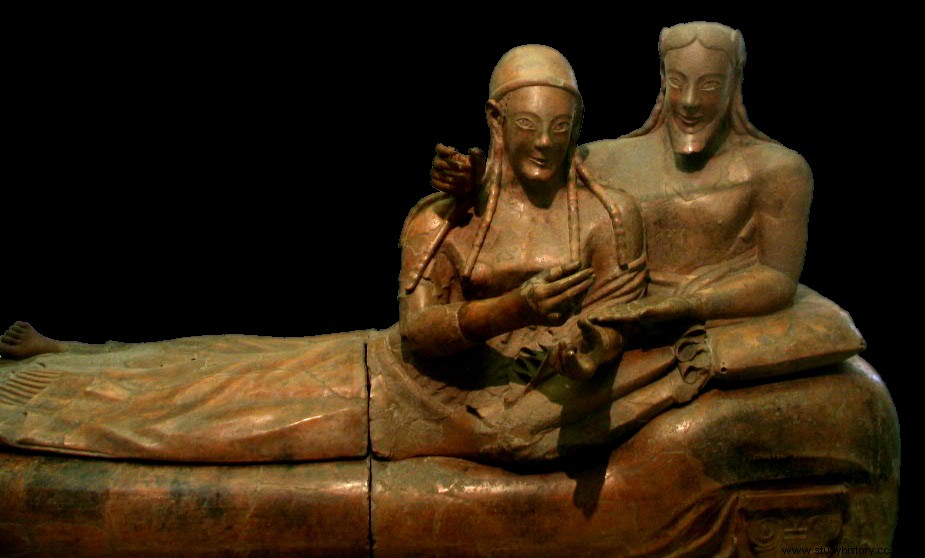
The 6th-century 'sarcophagus of the husbands':the Etruscans at the height of their power
The Etruscans inhabited city-states in present-day Tuscany, Umbria and Lazio. They formed a cultural, but not always a political unit. The origin of the Etruscans was the subject of much discussion in antiquity:because of their foreign language and the clearly visible Eastern influences, some found it difficult to believe that the people were autochthonous. The most influential theory was that of Herodotus , who wrote that the Etruscans were originally emigrated Lydians. Some modern researchers also adhere to this thesis. Other hypotheses mention the Alps, Central Europe or Thessaly (or aliens, in certain, rather to be avoided, regions of the World Wide Web). Scientists have tried several times to solve the problem through DNA research, but the results each time point in a different direction (but never to aliens).
Whatever the case, the Etruscans were a force to be reckoned with in the Mediterranean for centuries. In particular of the 7 de until the first half of the 5 the century BC the cities flourished. Innovations in agriculture, exploitation of soil resources and the resulting artisanal production in turn enabled intensive long-distance trade, which the Etruscans eagerly took advantage of. Their prosperity became legendary in later times. Until the Battle of Cumae (474 BC), the Etruscans and their Carthaginian allies controlled the western Mediterranean, and the city-states also expanded overland. From the 4 de century, however, they collided with the territorial aspirations of growing Rome, to which they fell one by one over the next century and a half. Slowly the Etruscan culture also disappeared, and the inhabitants of Etruria assimilated with the Romans.
Notorious revelers
The fabulous wealth of the Etruscans also earned them the reputation of revelers. According to Diodorus Siculus the harvests in Etruria were so abundant that the Etruscans were able to organize a lavish banquet not once, but twice a day. Since the Etruscans were also great traders, all kinds of exotic foods were served in addition to local agricultural products. Theopompus vividly describes what he believed to be such a sumptuous banquet:large quantities of wine were consumed – not only by the men, but also by the women! -, after which the whole thing degenerated into an orgy in which the Etruscans did it with everyone:their wives, prostitutes, but preferably with young men, and that “while the lamps were still on”!
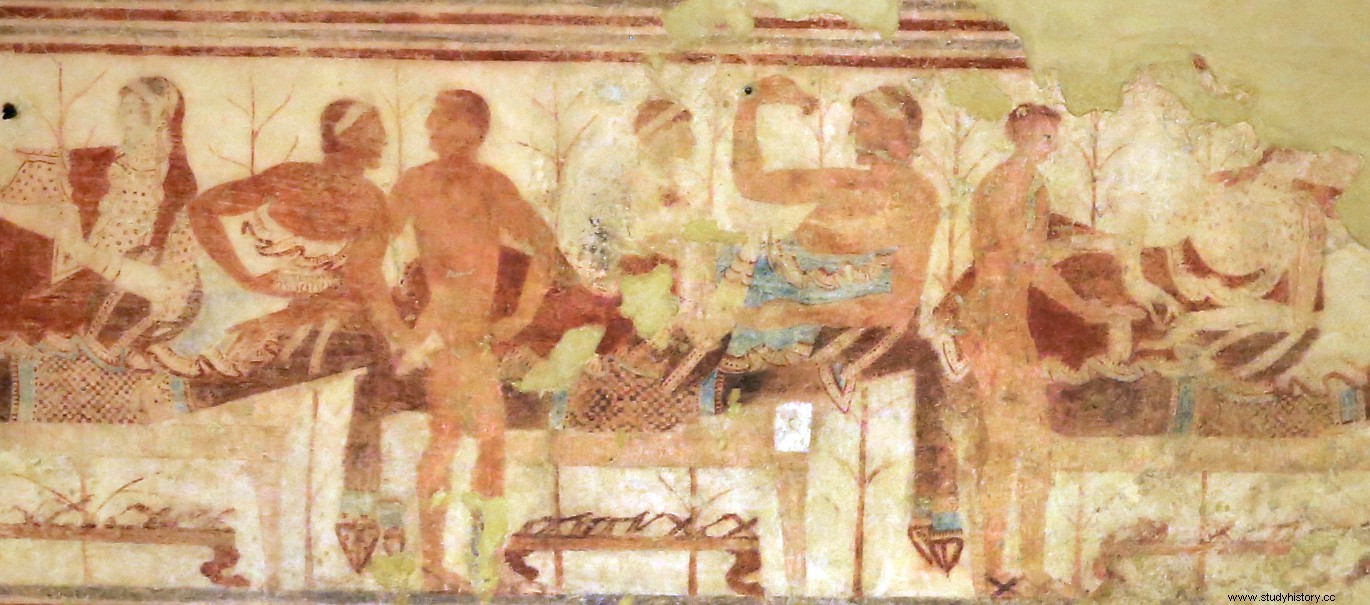
A typical banquet scene from the Tomba della Nave:although the slaves are naked, the women can hardly be called licentious
Paintings in Etruscan tombs also depict such banquets, but without the sexual escapades, which may well have been the result of the vivid imagination of Theopompus or his informants. We do, however, encounter women in these banquet scenes, a great contrast to the Greek world, where the life of the elite woman largely took place in the women's room. This relative freedom earned the Etruscan woman a bad reputation among the Greeks and the Romans. Of course, entertainment could not be missed during the meal, and the Etruscans are known for their love of music. Many images of banquets show dancers and musicians:mainly wind instruments, but also stringed instruments and percussion are represented. Some murals also depict the typical Greek drinking game kottabos .
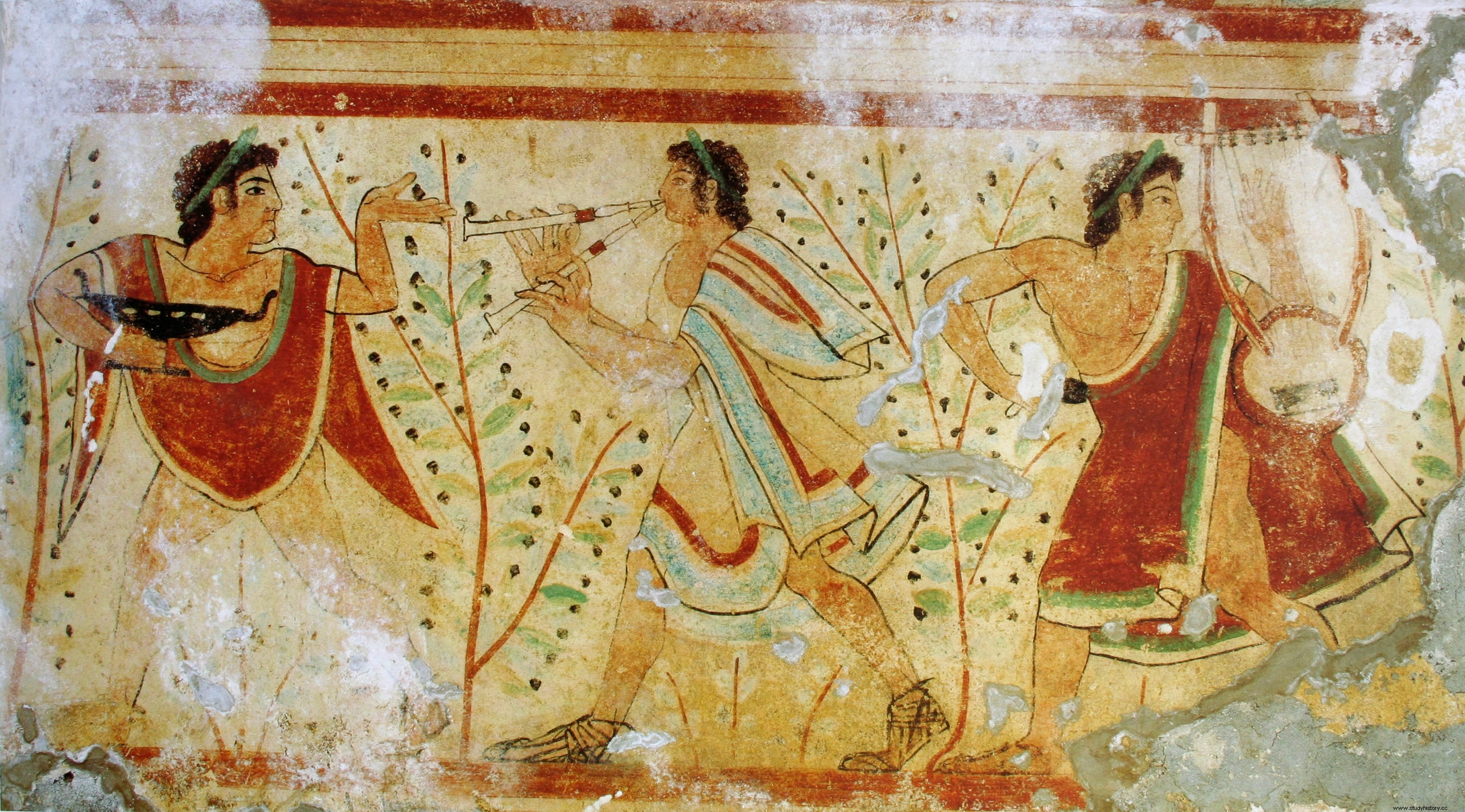
Musicians accompany a banquet in the Tomba della Leopardi
The 'obesus etruscus'
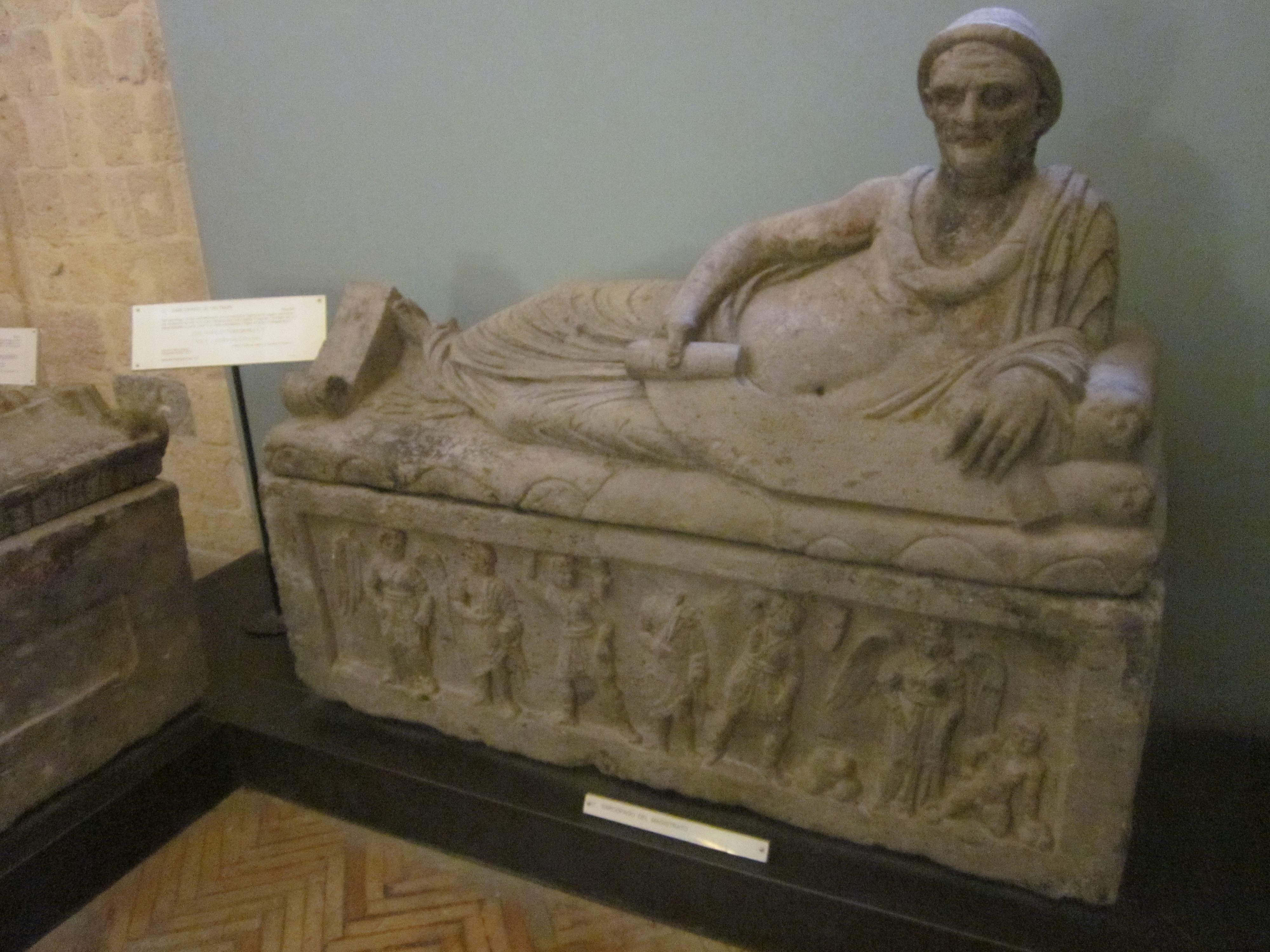
The sarcophagus of Lars Pulena, a distinguished resident of Tarquinia
In the eyes of the Romans, who were always wary of luxuria , of course nothing good could come of such ravings. The real or perceived Etruscan penchant for luxury and the ensuing decadence created an image of a weak, emasculated people. By the 1 th century BC added a related stereotype:that of the obese Etruscan. Catullus performs in his 39 th Ode, in which he denounces the social behavior of a Roman man, op. Virgil in turn speaks of the 'Pinguis Tyrrhenus', the fat Tyrrhene (another name for the Etruscans). The context is not necessarily negative, however:he describes a religious ceremony for which the Etruscans were famous, and later in the same poem the fertile soil is also referred to as pinguis described. So Virgil is more concerned with the abundance of the Italian land.
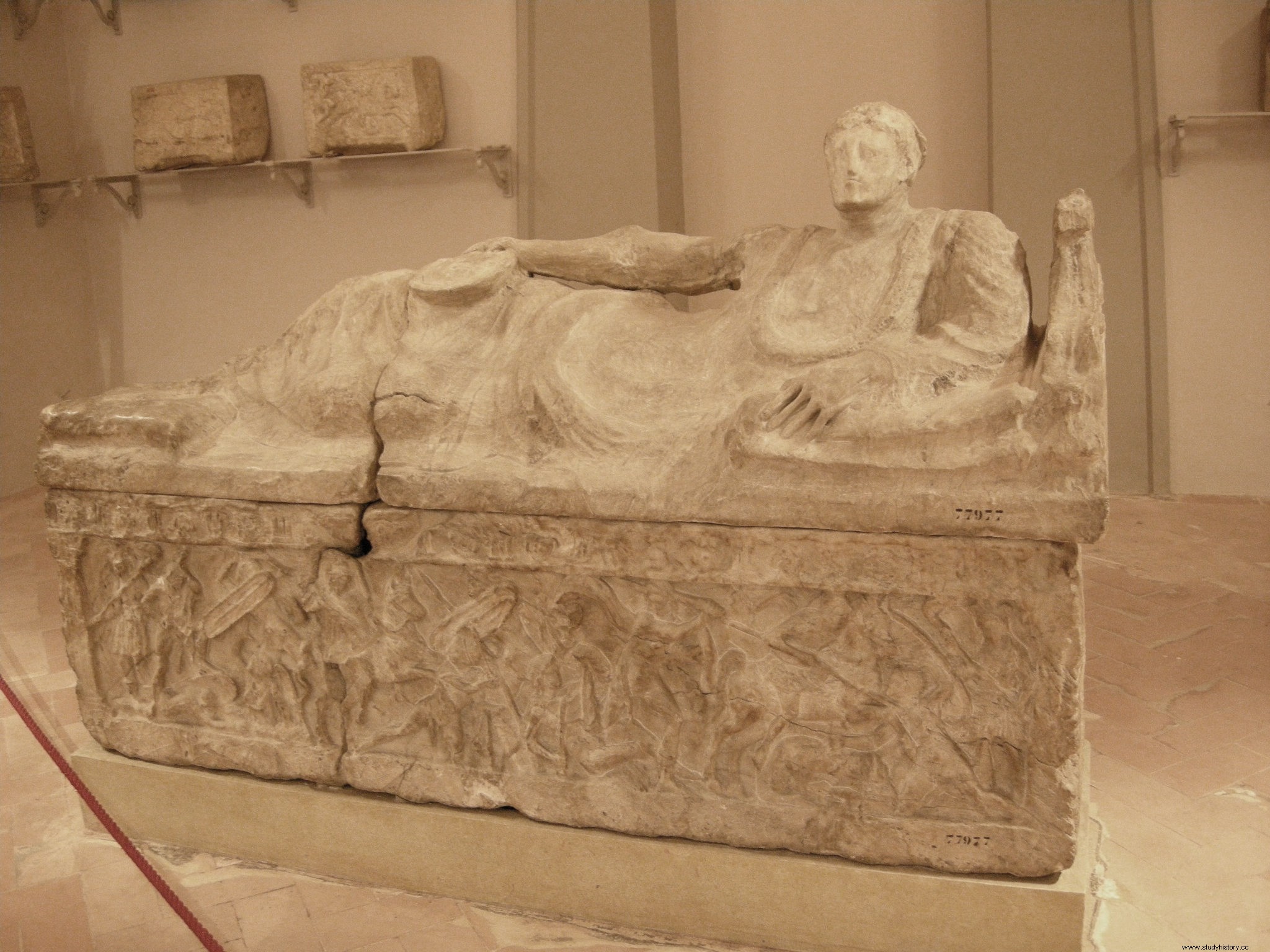
The so-called 'sarcofago dell'obeso' in the Museo Archeologico Nazionale di Firenze
20 ste Century historians connected these remarks with certain Etruscan sarcophagi, on which the deceased was depicted rather corpulent. However, these images date from the end of the fourth to the middle of the 2 th century, a hundred years before Catullus and Virgil were active. The sculptures are often contrasted with classical Greco-Roman art, which was previously averse to depicting imperfections. They are always men, often middle-aged and former magistrates or priests. The two poetic Roman passages, dating from very different times and contexts, are often combined with these objects to create the image of the unhealthy, decadent Etruscan:for example, this sarcophagus is referred to as the 'Sarcofago dell'Obeso', to Catullus' comment.
The Etruscan lifestyle
Is there any reason to believe that the Etruscans had an unhealthy lifestyle? Archaeological and iconographic sources indeed show the development of a banquet culture as part of the identity of the emerging aristocracy from the so-called Orientalizing period (700-575 BC). In this way the elite emphasized their wealth and economic power, which is nicely described in English as 'conspicuous consumption'. At such banquets, plenty of meat and wine was consumed, and the aristocrats who took part in them probably didn't pay much attention to their line. However, they were certainly not representative of the Etruscan population as a whole. Moreover, by no means all Etruscan aristocrats from the Hellenistic period were immortalized in a chubby way. Etruscans were also not portrayed as obese in other art forms.

Men and women reclining together in this banquet scene from the Tomba dei Leopardi
The diet of the average Etruscan, in all likelihood, looked very different from the famous aristocratic exploits. Archaeological research confirms the important role of grain products, and legumes such as beans and lentils were also regularly eaten. As in the rest of the Mediterranean, the olive also played an important role in the Etruscan diet. Traces of cattle ranching have also been found, and during the first millennium B.C. In particular, the breeding of pigs and the keeping of poultry became increasingly important. However, analysis of bones and teeth shows that most Etruscans ate largely vegetarian. Their consumption of meat was probably limited to religious and other ceremonies. In the coastal cities, of course, fish and shellfish were also part of the diet.

This relief from the tomb appropriately named Tomba della Caccia e Pesca depicts fishermen, among others
Sarcophagi:ideology and artistic trends
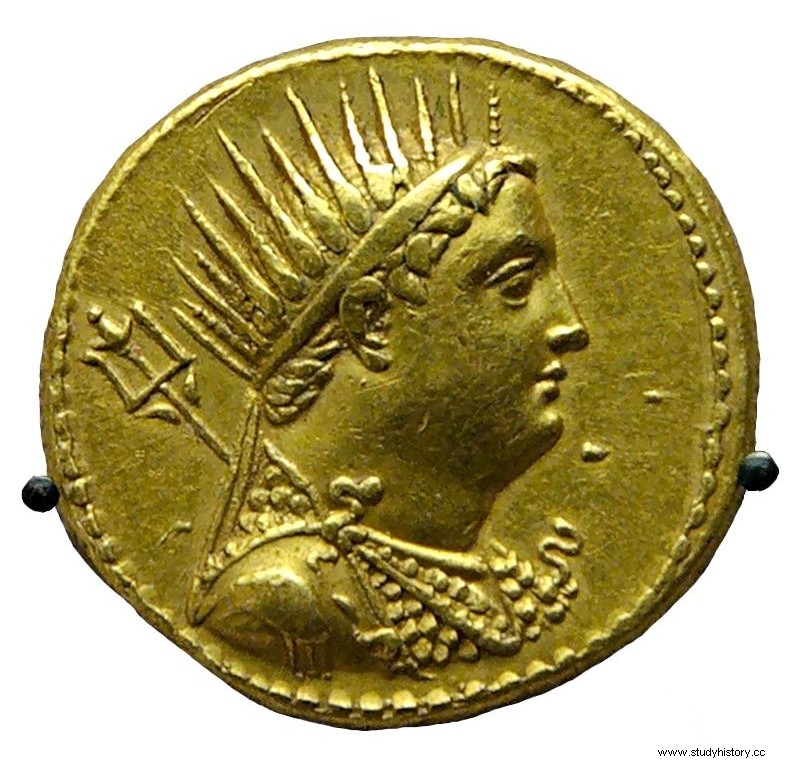
Octodrachm of Ptolemy III
The iconographic representations of 'obese' Etruscans are therefore limited overall:they only concern men, depicted on sarcophagi and urns during the Hellenistic period. Many of these works show stylistic similarities that suggest they were made in a limited number of workshops, for example in Chiusi. Earlier monuments from the same city, on the other hand, depicted highly idealized bodies. It is unlikely that the inhabitants of Chiusi suddenly regained their consciousness in large numbers over time. The depiction of the Etruscan body thus had more to do with cultural conventions. The link with the 'conspicuous consumption' and the abundance ideology of the Etruscan elite is then quickly made. Since these monuments are typical of the Hellenistic period, some researchers see a connection with the depiction of the Ptolemaic kings of Egypt (305-30 B.C.), in whose ideology abundance also played a major role. The first Etruscan examples, however, date from the late 4 de century. These are precious works of art, made with great eye for detail for prominent families; possibly this is a true depiction of these prominent persons, for whom a corpulent body radiated prosperity and health. From the 3 de century, such images became a real trend.
Roman stereotypes
A Roman who saw the same images probably interpreted the signals very differently than the Etruscans themselves. But the origin of the Roman conception of the "fat Etruscan" is rather related to the general image of decadence that the Roman authors of the Etruscans portray. Thus writes Posidonius that the Etruscans were formerly a manly and warlike people, but the Etruscans of his day passed their days in drinking and "unmanly" amusement. The Etruscans of the 1 st century BC were indeed no longer as powerful as their ancestors. For the Romans, this was due to the wealth of the original Etruscans, which made them soft and decadent, and ultimately led to their decline. These writers wanted to save Rome from the same fate. They thus problematized customs that are undesirable in a Roman context, such as the undoubtedly lavish banquets. For the Etruscan elite, however, this was a way of strengthening social ties within and outside the community. Even between these neighboring peoples, intercultural communication was not self-evident. The Roman sources tell us something about the Etruscan reality to some extent, but above all they reflect the values of the Roman elite. The moralizing writers were not particularly successful in their mission:today we mainly associate the Romans with lavish banquets and orgies!
